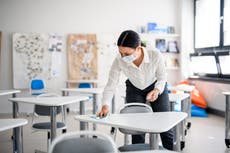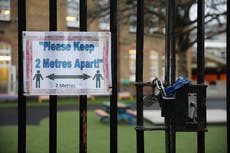Back to school: Everything you need to know about Covid testing and face mask rules
Primary and secondary school pupils have returned to classrooms
Your support helps us to tell the story
From reproductive rights to climate change to Big Tech, The Independent is on the ground when the story is developing. Whether it's investigating the financials of Elon Musk's pro-Trump PAC or producing our latest documentary, 'The A Word', which shines a light on the American women fighting for reproductive rights, we know how important it is to parse out the facts from the messaging.
At such a critical moment in US history, we need reporters on the ground. Your donation allows us to keep sending journalists to speak to both sides of the story.
The Independent is trusted by Americans across the entire political spectrum. And unlike many other quality news outlets, we choose not to lock Americans out of our reporting and analysis with paywalls. We believe quality journalism should be available to everyone, paid for by those who can afford it.
Your support makes all the difference.Primary and secondary school pupils in England have returned to classrooms as of Monday 8 March.
The return of students to classrooms was highlighted as a key priority for Boris Johnson as part of his roadmap to lifting lockdown measures announced in February.
Speaking to MPs on 22 February, the prime minister said: “All the evidence shows that classrooms are the best places for our young people to be and that's why I've always said that schools would be the last to close and the first to reopen.”
In a bid to limit the spread of Covid-19, the government revealed that mass testing in schools would be introduced.
The government has said that testing “will continue to be a vital part of our response to coronavirus”.
But how will this work in practice? Here’s everything you need to know.
How will Covid-19 testing in schools work?

Rules around testing differ according to age for students.
Secondary school and college students
Students will receive three initial tests at school or college in the first few days of school under the supervision of a trained operator, before transitioning to twice-weekly home testing.
Pupils will then continue taking twice-weekly swab tests using a home test kit provided by their school.
Students must report their result to NHS Test and Trace as soon as the test is completed, either online or by telephone, as set out in the home test kit instructions.
Primary school children
Low levels of transmission amongst younger children will not be regularly asymptomatically tested, however, but will be tested if they have symptoms.
How do I get hold of tests for home use?
The government has confirmed that free rapid lateral flow tests for twice-weekly testing will be given to all families and households with primary, secondary and college-aged children and young people, including childcare and support bubbles.
From 1 March 2021, if you’re a member of a household, childcare bubble or support bubble of staff or a pupil you can get a twice-weekly test:
- through your employer if they offer testing to employees
- at a local test site
- by collecting a home test kit from a test site
- by ordering a home test kit online
You can collect two packs of home test kits at a local collection point. Each pack contains seven tests.
Anyone 18 or over can collect a kit and you can check online if the location is busy before you go.
Click here to find your nearest home collection testing point.
What about testing for teachers and school support staff?
Teaching and non-teaching staff of primary and secondary schools should take twice-weekly tests using a home test kit provided by their school. This includes permanent, temporary and voluntary school staff.
Staff should contact their school for further details.
The government has confirmed that twice-weekly testing will also be offered to adults working in the wider school community, including bus drivers and after school club leaders.
How does rapid testing work?

A swab is taken from the nose or throat, and the specimen added to an extraction tube.
Drops of extraction solution are then added to the test cartridge, with results coming through in 20-30 minutes.
What about face masks?
The government says that face coverings should be worn by pupils and students in year 7 and above in classrooms and during activities unless social distancing can be maintained.
This does not apply in situations where wearing a face covering would impact on the ability to take part in exercise, such as in PE lessons.
Government guidance states that face visors or shields should not be worn as an alternative to face coverings.
Children in primary schools do not need to wear face coverings.
The government recommends that face coverings should be worn by staff and adult visitors in situations where social distancing between adults is not possible (for example, when moving around in corridors and communal areas.
Teachers and support staff are also required to wear face coverings in both primary and secondary settings.
What has the government said about mass testing?
Health and Social Care Secretary Matt Hancock said: “Regular testing of households and childcare support bubbles of primary and secondary school children is another tool we are making available to help keep schools safe.
“We know that one in three people with Covid-19 don’t have any symptoms, so targeted, regular testing will mean more positive cases are kept out of schools and colleges.”
He added that “sustained and repeated testing” for people without symptoms had a “critical” role to play as part of the relaxing of lockdown restrictions.
“By everyone playing their part and getting tested regularly, vital public services, workplaces and educational settings can stay open and running, and we can move closer to a more normal way of life,” he said.
Professor Yvonne Doyle, medical director at Public Health England, said: “These rapid tests help uncover hidden cases of the virus and break chains of transmission, stopping outbreaks before they occur.
“Combined with other protective measures, they are a vital tool to help us lower infection rates and ensure that they stay low.




Join our commenting forum
Join thought-provoking conversations, follow other Independent readers and see their replies
Comments